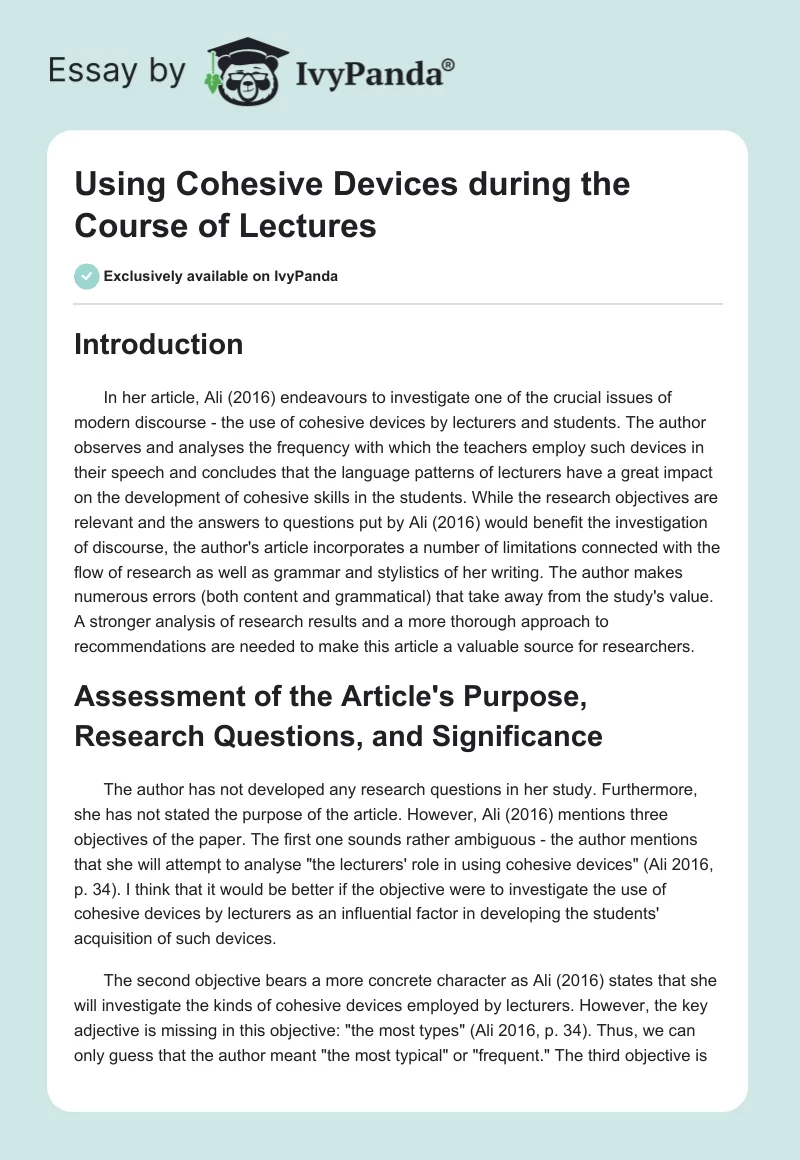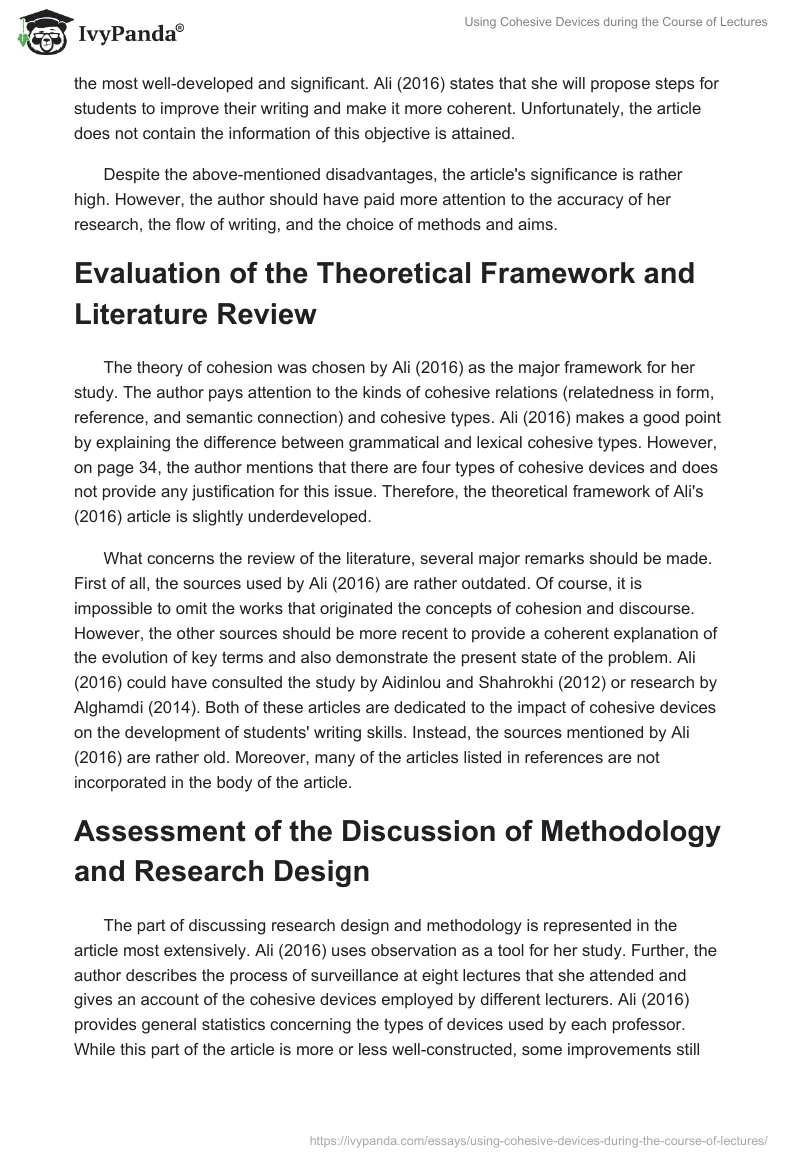Introduction
In her article, Ali (2016) endeavours to investigate one of the crucial issues of modern discourse – the use of cohesive devices by lecturers and students. The author observes and analyses the frequency with which the teachers employ such devices in their speech and concludes that the language patterns of lecturers have a great impact on the development of cohesive skills in the students.
While the research objectives are relevant and the answers to questions put by Ali (2016) would benefit the investigation of discourse, the author’s article incorporates a number of limitations connected with the flow of research as well as grammar and stylistics of her writing. The author makes numerous errors (both content and grammatical) that take away from the study’s value. A stronger analysis of research results and a more thorough approach to recommendations are needed to make this article a valuable source for researchers.
Assessment of the Article’s Purpose, Research Questions, and Significance
The author has not developed any research questions in her study. Furthermore, she has not stated the purpose of the article. However, Ali (2016) mentions three objectives of the paper. The first one sounds rather ambiguous – the author mentions that she will attempt to analyse “the lecturers’ role in using cohesive devices” (Ali 2016, p. 34). I think that it would be better if the objective were to investigate the use of cohesive devices by lecturers as an influential factor in developing the students’ acquisition of such devices.
The second objective bears a more concrete character as Ali (2016) states that she will investigate the kinds of cohesive devices employed by lecturers. However, the key adjective is missing in this objective: “the most types” (Ali 2016, p. 34). Thus, we can only guess that the author meant “the most typical” or “frequent.” The third objective is the most well-developed and significant. Ali (2016) states that she will propose steps for students to improve their writing and make it more coherent. Unfortunately, the article does not contain the information of this objective is attained.
Despite the above-mentioned disadvantages, the article’s significance is rather high. However, the author should have paid more attention to the accuracy of her research, the flow of writing, and the choice of methods and aims.
Evaluation of the Theoretical Framework and Literature Review
The theory of cohesion was chosen by Ali (2016) as the major framework for her study. The author pays attention to the kinds of cohesive relations (relatedness in form, reference, and semantic connection) and cohesive types. Ali (2016) makes a good point by explaining the difference between grammatical and lexical cohesive types. However, on page 34, the author mentions that there are four types of cohesive devices and does not provide any justification for this issue. Therefore, the theoretical framework of Ali’s (2016) article is slightly underdeveloped.
What concerns the review of the literature, several major remarks should be made. First of all, the sources used by Ali (2016) are rather outdated. Of course, it is impossible to omit the works that originated the concepts of cohesion and discourse. However, the other sources should be more recent to provide a coherent explanation of the evolution of key terms and also demonstrate the present state of the problem. Ali (2016) could have consulted the study by Aidinlou and Shahrokhi (2012) or research by Alghamdi (2014). Both of these articles are dedicated to the impact of cohesive devices on the development of students’ writing skills. Instead, the sources mentioned by Ali (2016) are rather old. Moreover, many of the articles listed in references are not incorporated in the body of the article.
Assessment of the Discussion of Methodology and Research Design
The part of discussing research design and methodology is represented in the article most extensively. Ali (2016) uses observation as a tool for her study. Further, the author describes the process of surveillance at eight lectures that she attended and gives an account of the cohesive devices employed by different lecturers. Ali (2016) provides general statistics concerning the types of devices used by each professor. While this part of the article is more or less well-constructed, some improvements still could have been made. The author should have provided a more detailed analysis of her observations.
Rather than merely stating that some devices were or were not used by a lecturer, Ali (2016) should have counted the frequency of their use. Such an approach would have given a more profound insight into the problem and would have delineated the most problematic zones. Also, it would be good if the author provided the lecturers’ level of education and their teaching experience. Such data would help to conclude whether the employment of cohesive devices by lecturers varies in accordance with their teaching experience and education level. Instead, all we can see from the author’s analysis of data is whether the lecturers used or did not use some cohesive devices. Still, Ali (2016) makes a productive conclusion about the general use of cohesive devices by lecturers.
Evaluation of the Findings and Recommendations
This part is the most poorly presented in Ali’s (2016) research. The findings merely reiterate the observation results in one sentence. The author gives some good suggestions for the improvement of the poor use of cohesive devices. However, these recommendations are not connected with each other and are not supported by any scholarly data. Ali (2016) mentions that lecturers should suggest activities that would enhance the learners’ writing skills, but she fails to give any examples of the possible solutions. In my opinion, the author could have strengthened this part by producing some practical recommendations about the ways of developing learners’ awareness and employment of cohesive devices. Of course, the lecturers’ example plays a crucial role, but there are other ways (for instance, self-education and self-development) that might help to solve the problem. Thus, the weakness of Ali’s (2016) recommendations is in their being too general.
Conclusion
Ali (2016) has performed an important study of a relevant issue in modern discourse analysis. She has organised the study design extensively and analysed it thoroughly. However, there is a number of limitations in Ali’s research. The author has not pointed out the purpose of her article and has not delineated any research questions. Literature used in the article is outdated, and not all sources listed in the references are reflected in the article’s body. Conclusions are too general, and no specific recommendations are given as to how the use of cohesive devices can be improved. It is suggested that in her future research work, Ali (2016) should pay more attention to the accuracy of her writing and expression of thoughts. In general, the purpose of Ali’s (2016) article is significant for modern linguistic research, but it needs considerable revision work that would emphasise the benefits of the study.
Reference List
Aidinlou, N A & Shahrokhi, H 2012, ‘The effect of discourse markers instruction on EFL learners’ writing’, World Journal of Education, vol. 2, no. 2, pp. 10-16.
Alghamdi, E A 2014, ‘Discourse markers in ESL personal narrative and argumentative papers: a qualitative and quantitative analysis’, International Journal of Humanities and Social Science, vol. 4, no. 4, pp. 294-305.
Ali, M E E 2016, ‘Using cohesive devices during the course of lectures “The lectures’ role”‘, International Research Journal of Social Sciences, vol. 5, no. 5, pp. 33-36.


